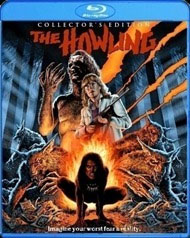 THE
HOWLING (1981) Blu-ray
THE
HOWLING (1981) Blu-rayDirector: Joe Dante
Scream Factory/Shout! Factory
 THE
HOWLING (1981) Blu-ray
THE
HOWLING (1981) Blu-rayNow THE HOWLING can be heard (and seen) clearer than ever in HD on Scream Factory’s special edition Blu-ray.
Severely traumatized after a near-fatal run-in with serial slayer “Eddie the Mangler” (Robert Picardo, 976-EVIL), Los Angeles news anchor Karen White (Dee Wallace, HOUSE OF THE DEVIL) and her husband Bill (Christopher Stone, CUJO) get away up north to “The Colony”, a retreat run by Dr. George Wagner (Patrick Macnee, BLOODSUCKERS) the consulting psychiatrist on the case. The residents of “The Colony” are weird enough, but Karen is certain that the howling she hears in the woods at night are not those of your average coyote (and has her fears confirmed when Bill is bitten by a wolf). Meanwhile Karen’s co-workers Chris (Dennis Dugan, NIGHT MOVES) and Terry (Belinda Balaski, PIRANHA) look into the background of the killer whose body has disappeared from the morgue…
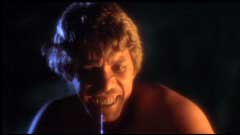
Based on a successful paperback by Gary Brandner (CAMERON’S CLOSET), the adaptation – started by Terence Winkless (THE NEST) and taken over by John Sayles (PIRANHA) – bears only a surface resemblance to the source with its young couple fleeing the city for the country to get over a trauma and finding werewolves. The script makes the inciting incident a little less random and pares down the sexual violence – the explicitness not unusual at all in 1970s and 1980s horror paperbacks – while not completely doing away with it (transferring Karen’s sexual violation to that of a woman in a projected porn film shot by Dante specifically for the film), as well as better tying the incident into the couple’s getaway destination. THE HOWLING is rather inconsistent scare-wise however. The first three quarters of the film with its serial killer plot and unseen menace in the woods all the way up to Terry’s stalking late in the film is wonderfully suspenseful and chilling (with a masterfully creepy performance from later STAR TREK fixture Robert Picardo). When the werewolf is viewed in full for the first time, however, the menace it poses to its victim takes a backseat to one’s marveling over the superior design of the creature compared to Lon Chaney’s or Paul Naschy’s wolfmen. From that point on, only the show-stopping effects – courtesy of Rob Bottin (THE FOG) and Rick Baker (who had to leave the production early to execute similar effects on AN AMERICAN WEREWOLF IN LONDON) – spike the hokiness of the climactic plot twist. The design of the final transformation kills any sense of real tragedy; but, by then, Dante has fully embraced the silliness and ends on a final joke that ends up being one of its most endearing.
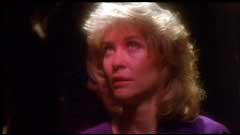 Although
Wallace had previously appeared in THE HILLS HAVE EYES and would later do CUJO,
she was remembered more for her role as the mom in E.T. and only later recognized
as a scream queen with guest appearances in Rob Zombie’s HALLOWEEN remake
and Ti West’s HOUSE OF THE DEVIL. Here, she is appropriately vulnerable
and neurotic; but, despite her dedicated performance, the audience’s concern
for her well-being diminishes once the menace shifts from monsters to talking
head exposition (with Dante and Hora condescending to Dutch angles to try to
impose a surreal air on the plot turn). The supplements on the disc reveal that
the climax had to be reshot more than once when the original concepts proved
laughable in execution; but the bigger problem is that the philosophical conceit
is never fully explored, only hinted at in a bunch of psychobabble about “the
animal within” from Macnee’s psychiatrist. Stone, who was engaged
to Wallace at the time and would also appear with her in CUJO, has less to do
since it’s pretty obvious from early on where his character arc will take
him what’s going to happen to his character –
even to those who have not read the novel – but he turns in an amiable
performance and gets a memorable effects set-piece before disappearing from
most of the last third or so of the film (Stone died suddenly in 1995 of a heart
attack). Dugan – better known now as a director of Adam Sandler comedies
– and Balaski are an engaging duo, but their investigation scenes disrupt
the set-up of “The Colony” as anything more than a nice-looking
location; also, they are more active in the trajectory of the plot than Wallace
and Stone’s central couple. Macnee gives a Christopher Lee-esque authority
to his role while he come across a bit more amiable and conflicted, but it is
Elisabeth Brooks as the carnal Marsha that makes the most striking impression
both in looks and as a performer; although she was one of the film’s most
memorable presences, she would not appear in another feature until 1988’s
DEEP SPACE (sadly, she died of cancer in 1997).
Although
Wallace had previously appeared in THE HILLS HAVE EYES and would later do CUJO,
she was remembered more for her role as the mom in E.T. and only later recognized
as a scream queen with guest appearances in Rob Zombie’s HALLOWEEN remake
and Ti West’s HOUSE OF THE DEVIL. Here, she is appropriately vulnerable
and neurotic; but, despite her dedicated performance, the audience’s concern
for her well-being diminishes once the menace shifts from monsters to talking
head exposition (with Dante and Hora condescending to Dutch angles to try to
impose a surreal air on the plot turn). The supplements on the disc reveal that
the climax had to be reshot more than once when the original concepts proved
laughable in execution; but the bigger problem is that the philosophical conceit
is never fully explored, only hinted at in a bunch of psychobabble about “the
animal within” from Macnee’s psychiatrist. Stone, who was engaged
to Wallace at the time and would also appear with her in CUJO, has less to do
since it’s pretty obvious from early on where his character arc will take
him what’s going to happen to his character –
even to those who have not read the novel – but he turns in an amiable
performance and gets a memorable effects set-piece before disappearing from
most of the last third or so of the film (Stone died suddenly in 1995 of a heart
attack). Dugan – better known now as a director of Adam Sandler comedies
– and Balaski are an engaging duo, but their investigation scenes disrupt
the set-up of “The Colony” as anything more than a nice-looking
location; also, they are more active in the trajectory of the plot than Wallace
and Stone’s central couple. Macnee gives a Christopher Lee-esque authority
to his role while he come across a bit more amiable and conflicted, but it is
Elisabeth Brooks as the carnal Marsha that makes the most striking impression
both in looks and as a performer; although she was one of the film’s most
memorable presences, she would not appear in another feature until 1988’s
DEEP SPACE (sadly, she died of cancer in 1997).
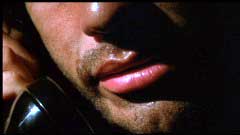
As expected of a Joe Dante film – even though this was only his official third feature – the supporting cast is entertainingly filled out with familiar faces including Kenneth Tobey (THE THING), Noble Willingham (CHINATOWN) and Slim Pickens (BLAZING SADDLES). Particularly memorable are INVASION OF THE BODY SNATCHER’s Kevin McCarthy (who had already done PIRANHA for Dante), John Carradine (of course), Don McCleod as Marsha’s creepy brother (already experienced with Baker/Bottin creature make-up from TANYA’S ISLAND), James Murtaugh (SOMEBODY’S WATCHING ME) – familiar to viewers during the period for his A1 Steak Sauce commercials – and Margie Impert (THE STAR CHAMBER), and Dick Miller (BUCKET OF BLOOD) in one of the film’s best bit parts as a bookseller. Also look out for amusing cameos by Roger Corman and Forest Ackerman (as usual, carrying an issue of Famous Monster of Filmland) as well as a small speaking part by screenwriter Sayles as the morgue attendant, and an early appearance by Meshach Taylor (although not quite as showy as his earlier turn in DAMIEN: OMEN II). Robert Burns’ art direction can’t help but suffer in comparison to his work on TEXAS CHAINSAW MASSACRE (even though he had a slightly larger budget here and does carry over some props from the earlier film), but the cinematography of Dante regular John Hora (GREMLINS) is often gorgeous, utilizing natural moonlight in a couple scenes (Jamie Anderson – who shot Dante’s HOLLYWOOD BOULEVARD and PIRANHA – as well as Gary Graver are given “special thanks” so they were probably involved in pick-ups or reshoots). One of the most memorable contributions, however, comes from composer Pino Donaggio whose symphonic work graced a number of low-budget American horror films – including HAUNTS and TOURIST TRAP – amidst his higher-profile collaborations with Brian De Palma starting with CARRIE.
 Released
on tape early on by CBS/Fox (and CED from RCA) and then quickly reissued by
Embassy on VHS and laserdisc (and later on tape by Nelson), fans had to contend
with the same fullscreen master of THE HOWLING for white a while until Image
Entertainment released a special edition laserdisc in 1995 featuring a widescreen
transfer and an engaging and humorous audio commentary by Joe Dante, Dee Wallace,
Christopher Stone and Robert Picardo (see below) as well as an interview with
David Allen on his effects work (only a couple frames of which survived the
final cut), deleted scenes, outtakes, the trailer, the shooting script, and
Donaggio’s score isolated on the right analog track. Non-laser collectors
had to wait until 2000 for another transfer when MGM released a sell-through
VHS edition. THE HOWLING made its DVD debut in 2001 courtesy of MGM in a 16:9
anamorphic widescreen (1.85:1) barebones DVD with only a trailer as an extra.
In 2003, MGM followed this up with a special edition featuring the same transfer
(as well as a 4:3 fullscreen release, and an additional 5.1 remix) on one side
of a double-sided disc with supplements on the reverse. Most of those supplements
from the 2003 DVD – including a hidden "Easter Egg" Dick Miller
interview – have been ported over to Shout! Factory’s 1080p24 AVC
MPEG-4 1.85:1 widescreen Blu-ray (a separate DVD release is also available)
including the laserdisc commentary. The film was licensed from MGM, but the
HD master was provided by Studio Canal who own most of the international rights.
Hora’s cinematography doesn’t look quite as slick as it once did
on DVD with more grain apparent during the blue night scenes and in the shadows
of the daylight sequences (particularly the foggy woods during Terry’s
stalking), but it seems truer to the budget and the preference for natural light
where practical. Audio is available in a full-bodied 2.0 DTS-MA original mono
track and a front-heavy 5.1 remix (optional English subtitles are also included).
Released
on tape early on by CBS/Fox (and CED from RCA) and then quickly reissued by
Embassy on VHS and laserdisc (and later on tape by Nelson), fans had to contend
with the same fullscreen master of THE HOWLING for white a while until Image
Entertainment released a special edition laserdisc in 1995 featuring a widescreen
transfer and an engaging and humorous audio commentary by Joe Dante, Dee Wallace,
Christopher Stone and Robert Picardo (see below) as well as an interview with
David Allen on his effects work (only a couple frames of which survived the
final cut), deleted scenes, outtakes, the trailer, the shooting script, and
Donaggio’s score isolated on the right analog track. Non-laser collectors
had to wait until 2000 for another transfer when MGM released a sell-through
VHS edition. THE HOWLING made its DVD debut in 2001 courtesy of MGM in a 16:9
anamorphic widescreen (1.85:1) barebones DVD with only a trailer as an extra.
In 2003, MGM followed this up with a special edition featuring the same transfer
(as well as a 4:3 fullscreen release, and an additional 5.1 remix) on one side
of a double-sided disc with supplements on the reverse. Most of those supplements
from the 2003 DVD – including a hidden "Easter Egg" Dick Miller
interview – have been ported over to Shout! Factory’s 1080p24 AVC
MPEG-4 1.85:1 widescreen Blu-ray (a separate DVD release is also available)
including the laserdisc commentary. The film was licensed from MGM, but the
HD master was provided by Studio Canal who own most of the international rights.
Hora’s cinematography doesn’t look quite as slick as it once did
on DVD with more grain apparent during the blue night scenes and in the shadows
of the daylight sequences (particularly the foggy woods during Terry’s
stalking), but it seems truer to the budget and the preference for natural light
where practical. Audio is available in a full-bodied 2.0 DTS-MA original mono
track and a front-heavy 5.1 remix (optional English subtitles are also included).
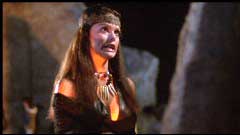
The commentary track is fact- and anecdote-filled but also warm and funny with the quartet happy to be reunited. While imparting his own recollections, Dante functions as a pretty good moderator. Dante recalls test screening one of the edits of the transformation scene to some kids (who of course ask why Wallace’s character didn’t run away), points out the real locations and sets, the various reshoots, scenes that were saved in cutting (due to his inexperience with complex blocking), and is critical of things that he felt did not work (including a “gratuitous” shot of a copy of Allen Ginsberg’s “Howl” which raises a chuckle but is not as smart as the other visual references including cans of Wolf Chili and some bits of background artwork). Dante’s recollections of Carradine are particularly hilarious. Wallace recalls the long night shoots as well as her feelings about the shooting of the sex scene between Stone and Brooks. Stone and Picardo also recall the lengthy and tiring make-up sessions (including the painful contact lenses and drool-inducing retracting fangs). Picardo also recalls creeping out casting director Susan Arnold with his audition (the porno booth scene), but also reveals that the lines for that scene in the final cut were redubbed later. This is one of those tracks that horror fans will probably revisit on more than one occasion.
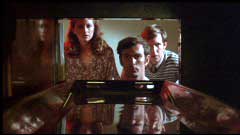 Scream
Factory has recorded a second commentary track with source novel author Gary
Brandner (moderated by Michael Felsher), whose only involvement with the actual
production was being informed that the book had been optioned (he also recalls
being invited to a screening in which Dante – who did not know who he
was – was dismissive of the book until Brandner announced from the audience
that he wrote it). There isn’t really a lot of commentary on the film
itself, which Brandner suggests is only faithful in terms of the werewolf sex
scene (although he is pleasantly distracted whenever Brooks appears onscreen)
but he maintains a positive opinion of the film. Much of the track instead focuses
on Brandner’s career, including his other novels and adaptations (CAMERON’S
CLOSET for instance). He does detail his involvement on HOWLING II that justified
his screen credit, which included several revisions moving the setting from
stateside to Spain to Yugoslavia before he chose to bow out. He is vague on
how many and how much of the sequels he has seen (although it is generally agreed
that HOWLING IV is truer to his original novel, he doesn’t really think
so), but he admits that he can’t really knock them since he gets royalties
and they keep his name visible. The track isn’t as informative or entertaining
as the director/cast track, but it might get you to check out some of Brandner’s
other books (I’ve got THE HOWLING II and HELLBORN somewhere on my desk
right now ready to read).
Scream
Factory has recorded a second commentary track with source novel author Gary
Brandner (moderated by Michael Felsher), whose only involvement with the actual
production was being informed that the book had been optioned (he also recalls
being invited to a screening in which Dante – who did not know who he
was – was dismissive of the book until Brandner announced from the audience
that he wrote it). There isn’t really a lot of commentary on the film
itself, which Brandner suggests is only faithful in terms of the werewolf sex
scene (although he is pleasantly distracted whenever Brooks appears onscreen)
but he maintains a positive opinion of the film. Much of the track instead focuses
on Brandner’s career, including his other novels and adaptations (CAMERON’S
CLOSET for instance). He does detail his involvement on HOWLING II that justified
his screen credit, which included several revisions moving the setting from
stateside to Spain to Yugoslavia before he chose to bow out. He is vague on
how many and how much of the sequels he has seen (although it is generally agreed
that HOWLING IV is truer to his original novel, he doesn’t really think
so), but he admits that he can’t really knock them since he gets royalties
and they keep his name visible. The track isn’t as informative or entertaining
as the director/cast track, but it might get you to check out some of Brandner’s
other books (I’ve got THE HOWLING II and HELLBORN somewhere on my desk
right now ready to read).
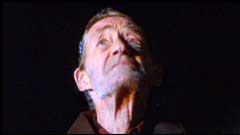
Ported over from the MGM DVD are the vintage documentary "Making a Monster Movie: Inside 'The Howling'" (8:01) and the newer retrospective on "Unleashing the Beast" (48:33). In the former – directed by Mick Garris (CRITTERS 2) – Dante espouses his preference for the more fantastic brand of horror over slashers and the requirement for humor. Macnee also expresses a general displeasure for the genre because of his wartime experiences but liked the project for skewing of everyday reality into the fantastic. Rob Bottin – who gets an associate producer credit – talks about the freedom given to him to realize the effects as well as the desire not to do the usual lap dissolve transformations. It’s basically an EPK puff-piece. The longer featurette includes the participation of Dante, Wallace, Picardo, Belinda Balaski, Dick Miller, producer Finnell, screenwriter Sayles, and cinematographer Hora which includes discussion of the pop psychology underpinnings of Sayles’ concept for the script, the use of color gels in the lighting, the poster concept (which soft-pedaled the werewolf aspect to make it look like a slasher), the basis of the werewolf design in old woodcuts, the mechanics of the revolutionary effects (including condoms used for the bladder effects) – as well as Peter Kuran’s animation – and Donaggio’s score (which was built around a church organ the composer found in Italy). The featurette includes some additional shots from the fake porno film and some of the effects that were scrapped (including David Allen’s stop motion wolves, some laughable suits, and the fiberglass “rocket wolves”).
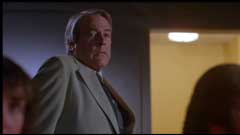 The
deleted scenes section (11:29) runs two minutes longer than the version on the
MGM disc (9:30), restoring the first half of the deleted hot tub scene. On the
MGM disc, this scene starts with Wallace alone in the hot tub hearing noises
in the forest around her. In the longer version here, Impert is in the tub with
her before climbing out (in long shot and partially obscured by a foreground
tree) and leaving her alone. Dante provides optional commentary to these scenes
(also not present on the MGM disc) and informs us over a scene featuring actor
Ivan Saric (whose performance apparently lost much to the cutting room floor)
was originally going to be named “Paul Naschy” but Dante thought
that would be too obvious of a reference so they named him “Jack Molina”
instead – Naschy’s real name being Jacinto Molina to the uninitiated
– two years before English prints of Naschy’s directorial effort
THE CRAVING would be signed “Jack Molina”. The film from the porno
booth scene is not included; it was featured as an extra on the recalled pressing
of the previous German DVD so one can assume that its omission is intentional.
The outtakes (7:03) also run longer than the section on the MGM disc (5:18),
restoring an opening flub by McCarthy during the ending with Wallace on the
monitor in the background starting her speech about werewolves. The MGM version
begins with Balaski on the beach which makes it a bookend to the segment’s
final outtake from the same scene. Ported over from the laserdisc is the interview
with the late stop-motion effects artist David Allen (8:48), who is understandably
miffed that much of his work doesn’t appear in the final film but for
a few shots during a dissolve. He recalls the confused nature of the reshooting
and restructuring of the effects sequences, and that his work poorly matched
the surrounding scenes. Several views of the stop-motion animated werewolves
are shown in this segment, and they would have been a bad fit (kind of like
that stop motion creature that pops up in the lab in PIRANHA for a single shot).
The
deleted scenes section (11:29) runs two minutes longer than the version on the
MGM disc (9:30), restoring the first half of the deleted hot tub scene. On the
MGM disc, this scene starts with Wallace alone in the hot tub hearing noises
in the forest around her. In the longer version here, Impert is in the tub with
her before climbing out (in long shot and partially obscured by a foreground
tree) and leaving her alone. Dante provides optional commentary to these scenes
(also not present on the MGM disc) and informs us over a scene featuring actor
Ivan Saric (whose performance apparently lost much to the cutting room floor)
was originally going to be named “Paul Naschy” but Dante thought
that would be too obvious of a reference so they named him “Jack Molina”
instead – Naschy’s real name being Jacinto Molina to the uninitiated
– two years before English prints of Naschy’s directorial effort
THE CRAVING would be signed “Jack Molina”. The film from the porno
booth scene is not included; it was featured as an extra on the recalled pressing
of the previous German DVD so one can assume that its omission is intentional.
The outtakes (7:03) also run longer than the section on the MGM disc (5:18),
restoring an opening flub by McCarthy during the ending with Wallace on the
monitor in the background starting her speech about werewolves. The MGM version
begins with Balaski on the beach which makes it a bookend to the segment’s
final outtake from the same scene. Ported over from the laserdisc is the interview
with the late stop-motion effects artist David Allen (8:48), who is understandably
miffed that much of his work doesn’t appear in the final film but for
a few shots during a dissolve. He recalls the confused nature of the reshooting
and restructuring of the effects sequences, and that his work poorly matched
the surrounding scenes. Several views of the stop-motion animated werewolves
are shown in this segment, and they would have been a bad fit (kind of like
that stop motion creature that pops up in the lab in PIRANHA for a single shot).
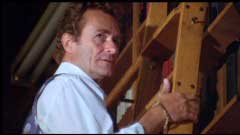
Shout! in association with Red Shirt Pictures have shot a number of new interviews. Executive producer Steven A. Lane "Howling Eternal" (18:49) in which he reveals that he purchased the book rights and put together the original package, but did not become a hands-on producer until THE HOWLING II (for better or worse) when Avco Embassy did not exercise their sequel rights. A theater owner, Lane noticed Brandner’s novel in a shopping center and discovered that the rights had been optioned originally by Warner but were at the time with Jack Conrad – whose only other credits were COUNTRY BLUE (1978) and the live-action segments of the X-rated animation ONCE UPON A GIRL (1980) – who had scripted an adaptation with the intention of directing it. Lane got involved with producer Daniel Blatt (BLOODY BIRTHDAY) who brought on Michael Finnell. When Conrad’s and Lane’s visions for the project differed, Finnell brought on Joe Dante (Finnell had produced the Dante's ROCK ‘N ROLL HIGH SCHOOL and would produce several of his films up through SMALL SOLDIERS for DreamWorks). Lane partnered with Hemdale for the sequel and the film went into production without funding finalized. He describes the shooting conditions in Czechoslovakia with old equipment, police concern over the number of punk extras, and inexperienced crew members. Lane blames Hemdale’s John Daly for the repeated use of the shot of Sybil Danning ripping off her top (to the actress’ displeasure). His discusses in brief his involvement in the other entries of the series including the dire “vanity project” HOWLING: NEW MOON RISING, which Lane says it was the idea of Allied Vision’s Edward Simons and star/director Clive Turner (HOWLING V) to create a new story around footage from the earlier entries (he did not see the film until it came out on videotape). Of the TWILIGHT-ed THE HOWLING: REBORN, he describes it as “nothing to be ashamed about”.
 In
"Cut to Shreds" (11:20), editor Mark Goldblatt talks mainly about
the difficulty of shooting and editing the transformation set-piece. Also included
is an interview with Terence H. Winkless (12:32), later director of THE NEST,
who started the adaptation before Sayles was brought on. His original concept
called for Karen to be bitten by her attacker and then go undercover at “The
Colony” unaware that it was a haven for werewolves. According to Winkless,
the writing job paid less than his studio work but it did come with an onscreen
credit (which got him more directorial work than writing jobs). In "Horror's
Hallowed Grounds" (12:15), host Sean Clark revisits the film’s locations
including the bookstore (now a souvenir shop that has unfortunately been heavily
remodeled) and the Marsha’s cabin which has not changed all that much
in the intervening years. The film’s theatrical trailer (1:28) and a photo
gallery close out the set. (Eric
Cotenas)
In
"Cut to Shreds" (11:20), editor Mark Goldblatt talks mainly about
the difficulty of shooting and editing the transformation set-piece. Also included
is an interview with Terence H. Winkless (12:32), later director of THE NEST,
who started the adaptation before Sayles was brought on. His original concept
called for Karen to be bitten by her attacker and then go undercover at “The
Colony” unaware that it was a haven for werewolves. According to Winkless,
the writing job paid less than his studio work but it did come with an onscreen
credit (which got him more directorial work than writing jobs). In "Horror's
Hallowed Grounds" (12:15), host Sean Clark revisits the film’s locations
including the bookstore (now a souvenir shop that has unfortunately been heavily
remodeled) and the Marsha’s cabin which has not changed all that much
in the intervening years. The film’s theatrical trailer (1:28) and a photo
gallery close out the set. (Eric
Cotenas)